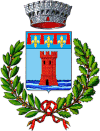Castel d'Aiano
| Castel d'Aiano | ||
|---|---|---|

|
|
|
| Country | Italy | |
| region | Emilia-Romagna | |
| Metropolitan city | Bologna (BO) | |
| Local name | Castèl d Ajàn | |
| Coordinates | 44 ° 17 ' N , 11 ° 0' E | |
| height | 805 m slm | |
| surface | 45.25 km² | |
| Residents | 1,854 (Dec. 31, 2019) | |
| Population density | 41 inhabitants / km² | |
| Post Code | 40034 | |
| prefix | 051 | |
| ISTAT number | 037013 | |
| Website | www.comune.casteldaiano.bo.it | |
Castel d'Aiano is an Italian commune ( comune ) with 1854 inhabitants (as of December 31, 2019) in the metropolitan city of Bologna , Emilia-Romagna region .
location
Castel d'Aiano is located at 805 m slm in the Tuscan-Emilian Apennines , making it one of the highest municipalities in the metropolitan city of Bologna. Their territory extends along the watershed of the Reno and Panaro Rivers .
history
The construction of the fortress of Aiano began between the 7th and 8th centuries and was renewed in the 10th century in the elevated part of the area. The municipal area is located in the borderland and was therefore disputed between Modena and Bologna for a long time before it finally came under the rule of Bologna. Castel d'Aiano was part of the last front straightening of the Goths position during World War II and was almost completely destroyed during the bombing of November 1944. During the Allied spring offensive in 1945, Castel d'Aiano, defended by the 334th Infantry Division , was captured by the 10th US Mountain Division on April 14th .
Administrative division
The municipality of Castel d'Aiano also includes the five fractions Casigno, Rocca di Roffeno, Santa Maria di Labante, Sassomolare and Villa d'Aiano.
Attractions
Worth mentioning are the hamlet of Rivola near Villa d'Aiano with its tower from the 16th century, the Casetorri (tower houses) of Poggiolo and Monzone (18th-19th centuries), the Torre di Lavacchio from the 16th century and the noble residential complex from Torre Jussi (16th - 17th century) with the house of prayer of the Annunziata (18th century) in Rocca di Roffeno. In Casigno the Casa Landi and La Palazzina are other buildings worth seeing. In Labante can see the old mill stones of today powered mill Povolo admire, while causing a whimsical limestone deposit in San Cristoforo the spring water, sponga called, and the famous caves of Labante unearthed.
In the woods of Monte Castellana lies the village of Stella mattutina (morning star), the summer residence of the Counts Nanni-Levera , the owners of the Aneva valley, who also owned the Castello Manservisi . In Roffeno, on the old Via Nonantolana , is the church of Santa Lucia , a former Benedictine monastery.
Lady Chapel of Brasa
According to legend, two young shepherds noticed the face of Mary on a chestnut tree. The votive chapel of the Madonna of Brasa was built at this point . Erected at the beginning of the 18th century, it was rebuilt in the early 1960s after being destroyed in the Second World War. It is not far from Castel d'Aiano on the Brasa Pass . The feast of the Madonna di Brasa takes place every year on the last weekend in August.
Web links
Individual evidence
- ↑ Statistiche demografiche ISTAT. Monthly population statistics of the Istituto Nazionale di Statistica , as of December 31 of 2019.
- ↑ Spiegel Online - One day this article
- ↑ Marco Belogi, Daniele Guglielmi: Spring 1945 on the Italian front: a 25 Day Atlas from the Apennines to the Po River. Primavera 1945 sul fronte italiano: Atlante dei 25 giorni dall'Appennino al fiume Po. Mattioli 1885, Fidenza 2011 ISBN 978-88-6261-198-5 . Pp. 181-182
- ^ Castel d'Aiano. In: comune.casteldaiano.bo.it. Retrieved February 17, 2020 (Italian).
- ↑ Manservisi Castle. In: castellomanservisi.it. Retrieved February 17, 2020 (Italian).
- ↑ Festa della Madonna di Brasa. In: comune.casteldaiano.bo.it. Retrieved February 17, 2020 (Italian).

